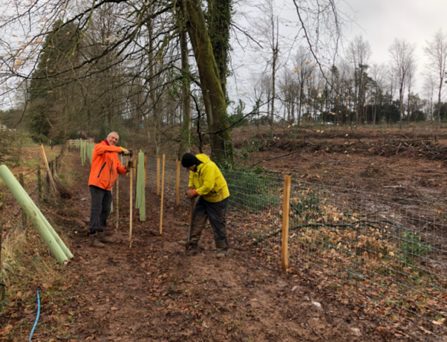Keen walkers will have seen over Jan/March that 16 acres of mature beech and pine plantation has been felled. These trees were planted post war using government tax relief on an area that used to be rough pasture. As mature trees the canopy was very dense leading to vegetation of very poor diversity (almost entirely stunted, non-fruiting bramble) growing on the wood floor. Few invertebrates and even fewer birds, bats and other animals were able to use the space due to the lack of food.
AWT experts marked specific trees which had hollows or other features which might form natural future nesting holes and these trees have been left standing. The entire 16 acres has been fenced with stock fencing and cattle and pigs are being introduced. The pigs are only hoped to be on site for a short time, simply to eat the brambles and their roots in order to stop the area becoming an impenetrable bramble thicket. The bare ground they create through rootling will make seeding the area more rapid. The cattle will be a permanent addition, and will help the goats graze the neighbouring grassland, but with freedom to move it is hoped their coats and dung will help transport seeds into the newly felled area and bring in diversity. Additionally the cattle dung is the food source for dung beetles – themselves the main food source for horseshoe bats (one of the species that stands to greatly benefit from the felling).
Around the area a mixed natural species hedge has been planted by the volunteers. The hedge comprises species that will provide much needed food for local wildlife – e.g. blackthorn (sloes), hazel (nuts), crab apple (fruit), spindle (berries), purging buckthorn (berries, and the leaves are the foodplant for the caterpillars of brimstone butterflies), and some oaks. The hedge will also acts as a corridor for woodland animals: bats will use the planting for navigation and hunting along, dormice (a tree dwelling species) will use the hedge line as a movement corridor to cross between different areas of the woodland, and glow-worms will use the edge areas to find a mate.
You’ll also see a lot of large brash piles (piles of branches, leaves, and earth) dotted around the site. These are a valuable resource for woodland life – insects, small mammals, reptiles, birds, and fungi will all exploit these features – for living within, nesting in, feeding on, and hibernating in. Before long they’ll be colonised and brimming with life, there may even be birds making nests in them already.
Over the next 6-7 years the plan is that we will see natural regeneration of this area with a variety of local tree species and abundant wildflowers. Any bare areas would then be planted with young trees. Over time we’ll see more butterflies and birds something that AWT are keen to see across their entire land holding.


